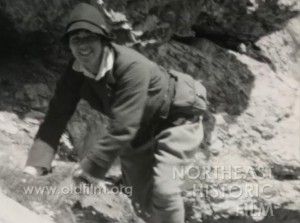"King Bookie: John Cowart set himself a tremendous goal in undertaking the production of this dramatic film, which has to do with bank robbers. But thanks to his zeal, his all around ability in movie making, the sincerity and cooperation of his amateur cast, and the cooperation of local merchants who happily contributed the use of their business establishments for locations, he has turned out a highly creditable production. The picture opens with a girl, unwittingly involved in the robbery, relating to an attorney events of the story which is pictured in retrospect. King Bookie is an underworld character who plots the crime, involves several others, some of whom meet death by his gun when the proceeds are retrieved from one gang member who sought to double-cross King Bookie. Narration, dialogue and musical score are a commendable effort of sound-on-film recording." American Cinematographer, May. 1951, 190.
According to the filmmakers, "The scenario was our own—concerning the difficulties confronting a British telegraph company in maintaining communications between Uganda and the Sudan. A story requiring such foreign locale—Africa's desert, veldt and jungle—was written with the object of demonstrating to our audiences the cinema possibilities of our northeastern states" (111).

"David W. Kean has made a simple expository film of a two-man gold mining outfit. But in it he has kept the human touch. A well written narrative supplements the pictured material in explaining the various operations that ultimately produce man's most valued metal. Interior and underground scenes are competently handled and surmount what must have been difficult lighting problems. The production of King of Metals is aptly in scale with the extent of its subject matter." Movie Makers, Dec. 1950, 468.
"'Kleptomania,' the entry of Bion Vogel of the Los Angeles 8mm. Club, was an excellent black and white scenario film. Its main weakness lay in uneven lighting and composition." American Cinematographer, Feb. 1938, 76.

"The Knife is a deft little story film concerning a jealous husband who suspects a local artist of making time with his wife. Grabbing the artist's knife, he stabs the artist in the back, but the result is not at all what he, nor the audience, expects" PSA Journal, Sept. 1966, 35.
"Excellent handling of camera and lights. A nice story telling family film starring Maxine (who has appeared in several other prize winning films) and her new baby." PSA Journal, Dec. 1955, 37.
"The Kokanee Salmon is a fine documentary on the raising of this little known species of salmon. We see how the eggs are collected an subsequently fertilized, and later how the little fish are let loose in the stream to end up on some lucky fisherman's hook. It was declared the best documentary film, and also won the MPD Nature Film Award" PSA Journal, Aug. 1967, 36.
"Kaneko also made a few films that explored the theme and style of the city symphony genre. In Kōkyōgaku (Symphony, 9.5mm, 1930), which is less than three minute long, Kaneko edited together shots of very short duration that captured objects such as trees, water, and rail tracks; Kaneko described this work as an attempt to create “the movement of objects in symphonic ways.”" - Noriko Morisue, "Filming the Everyday: History, Theory, and Aesthetics of Amateur Cinema in Interwar and Wartime Japan" (Yale University: PhD Dissertation, 2020): 110.
Total Pages: 299